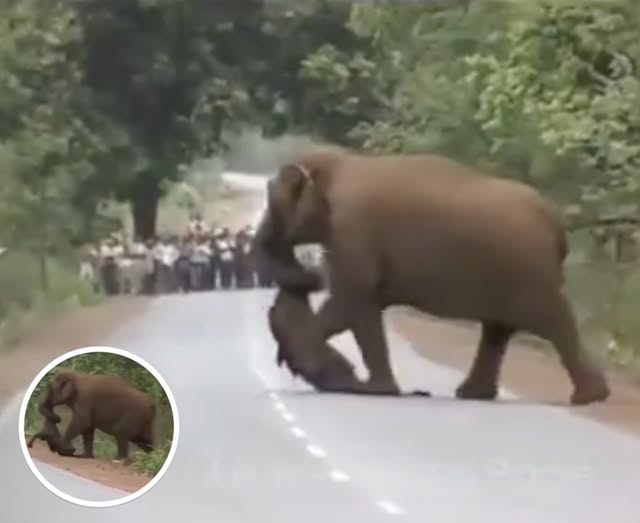A powerful and emotional moment captured in the wild has left thousands of people around the world stunned and deeply moved. In a viral video that quickly spread across social media, an adult Indian elephant is seen gently cradling the lifeless body of a young elephant with its trunk as it emerges from a forest onto a quiet road. What followed resembled something achingly human—a funeral procession, marked not by words, but by gestures, stillness, and heartbreaking grace.
The video was shared by Parveen Kaswan, a forest ranger with the Indian Foreign Service, who witnessed the event and posted it to Twitter. In the footage, the adult elephant lays the young elephant’s body on the road and waits in solemn silence. Soon, members of the herd appear one by one, forming a line along the road as if honoring the fallen. Together, they surround the small body with tender stillness before lifting it and slowly carrying it back into the forest. Their movements were measured, deliberate, almost reverent.
Viewers around the world were struck by the haunting beauty of the moment. The video received thousands of retweets and likes, sparking conversations across the internet about grief, emotion, and the complex inner lives of animals. One user, Devika, wrote, “This is heart-rending. There’s a lot that humans can learn from animals.” Another, Sumita Bhatt, commented, “Omg!!! First time I’ve seen such a video… really very touching.” Mohan Alembath added, “The emotional intelligence of elephants never ceases to amaze me.”
Though some scientists caution against assigning human emotions too freely to animals, elephants are widely recognized as one of the most emotionally complex species in the animal kingdom. According to the Smithsonian magazine, elephants have been observed returning to the remains of deceased herd members, gently touching and smelling the bones, and standing vigil for extended periods. These acts suggest an awareness of death and an emotional response to it, even if not fully understood by science.
This wasn’t the first time animals have been seen mourning in such a moving way. In a now-famous event from the previous year, a female killer whale made headlines around the world after she carried her dead calf on her back for more than two weeks through the waters of Canada, refusing to let go. Chimpanzees in captivity have been observed gathering around a deceased companion, cleaning the body, and showing visible signs of grief. In Zambia, researchers watched a mother chimp gently clean the teeth of her deceased son using a blade of dry grass—another quiet but powerful expression of lingering love.
Other species have shown similar behaviors. Magpies have been known to bury their dead under tufts of grass, while groups of peccaries—pig-like mammals native to the Americas—have been recorded repeatedly visiting a deceased herd member, lying beside it and nuzzling it for hours or even days.
These incidents, though rare and fleeting, shine a light on the deeply social nature of many animals and the invisible emotional threads that connect them. What may seem like instinct is often more layered—loyalty, grief, ritual, and even a sense of community can be glimpsed in these extraordinary moments.
For those who saw the elephants carry their young companion back into the forest, it wasn’t just nature in motion—it was a profound reminder that empathy and mourning are not exclusive to our species. Life, in all its fragile beauty, is shared more deeply across the animal world than we often realize.
In a world so often filled with noise, this silent procession spoke louder than words ever could.
